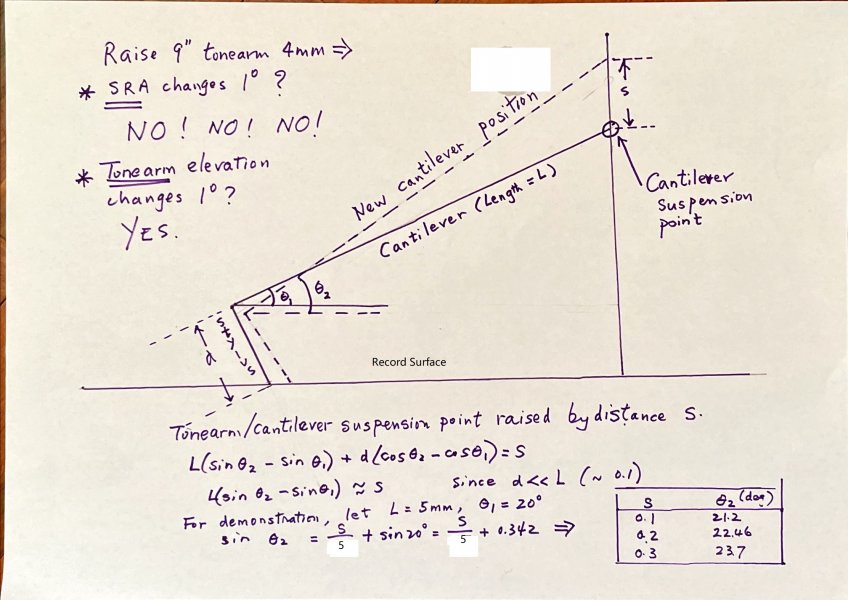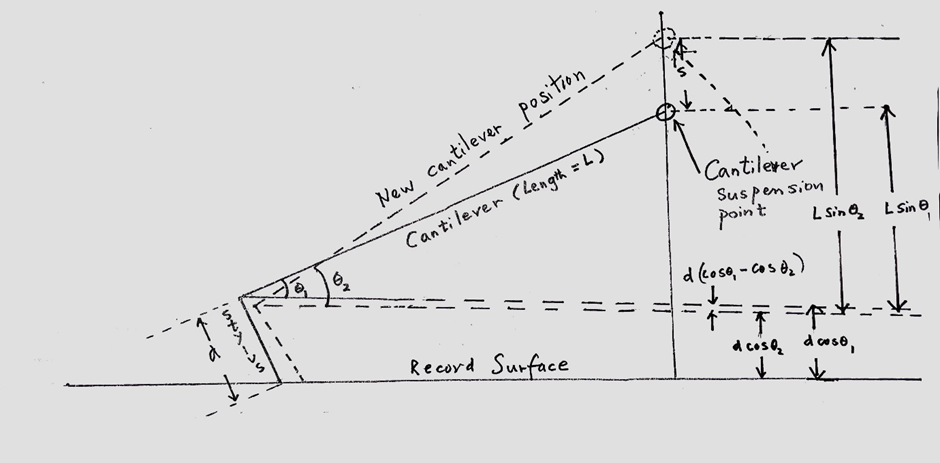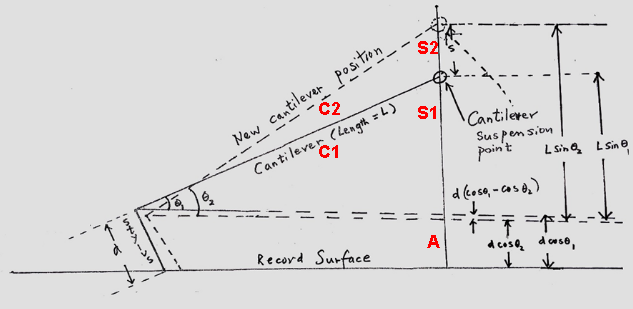Iamn0, thanks for bringing this thread to my attention. Here’s my thoughts:
When you raise and lower a non-tangential tonearm the point of rotation is actually in two locations without fail: about the stylus tip AND at the horizontal junction of the line formed by the offset angle and the armtube (I'm oversimplifying here for ease of understanding). These two points remain the only points of rotation UNLESS VTF changes as tonearm height changes. In such cases there will ALSO be rotation of the cantilever with the point of rotation being behind the coil former. This condition will then have the effect of lowering/raising the cantilever pivot point relative to the record surface, thereby changing SRA/VTA.
Assuming NO change in VTF when tonearm height is changed (which would require a tonearm in which the arm’s horizontal pivot was coincident to the arm/cartridge center of gravity - this is quite uncommon despite some tonearm manufacturer claims), you are correct if you are trying to make the point that a ~4 mm change in tonearm height will cause approximately 0.1 mm change in height of the cantilever’s point of rotation (again, behind the coil former). In my cartridge analysis reports I include a statistic where I measure what happens to SRA/VTA if the height of the cartridge drops by 0.1 mm (which is not out of the realm of possibility for some cartridges as they break in). The formula uses starting cantilever angle and cantilever length as factors but the result is always somewhere around 1 degree.
Now to those who can hear differences with tiny changes to arm height: I believe it is *possible* to hear a fraction of a mm in height change, though it does beg for blind testing. I am NOT saying such people are fooling themselves. I am simply saying that it seems unlikely to me that one could consistently discern whether the tonearm height was changed by, say, 0.2mm. However, I have been surprised MANY times before in this hobby so I am prepared to be wrong about this. As mentioned above by the very knowledgeable fellows Dave Slagle and Mtemur, a change in arm height causes changes to azimuth (as a function of the offset angle) and usually also VTF AT LEAST. Now, when VTF changes you can expect a host of conditions change for playback that are intrinsic to the motor function and even to the resonance of the cartridge/arm union.
By way of reference, on the Kuzma 4point tonearm the center of gravity is so far above the horizontal bearing that changing tonearm height makes almost no impact on rake due to increasing/decreasing VTF - but it most certainly changes the sound! The Kuzma is rather unique in having a COG above the horizontal bearing, of course. On perhaps most tonearms, the COG is below the bearing and the principal is reversed: changes to arm height result in disproportionately large changes to SRA/VTA.
The more research our team does, the more I become convinced that we should usually refer to “SRA/VTA” instead of the individual components separately. This is because changing tonearm height changes both SRA and VTA (obviously) but we need to understand that the impact of angular changes for each are sensitive for different reasons/conditions and each has its own target ideal based upon cutterhead design and alignment. SRA is sensitive almost exclusively to horizontal modulation of the groove content and VTA is sensitive exclusively to vertical modulation of the groove. This will be the subject of our second technical paper to submit to the Journal of Audio Engineering Society. For now, suffice it to say that of the cartridge alignment parameters (SRA/VTA, azimuth, zenith) both SRA and VTA are the LEAST sensitive to angular change - even on a fine line contact stylus. This has been confirmed in finite element analysis and again in Matlab.
This relative lack of sensitivity is a REALLY good thing for us since cutting rake angle and torque tube cutting angles are NOT uniformly targeted by engineers nor even by European vs American cutterhead design (UNLIKE the last two parameters which are not up for debate: azimuth and collinearity of the lacquer's radial line with the two cutting edges of the cutting stylus, a.k.a., "zenith"). However, with the advent of stereo cutting and its required vertical modulations of the lacquer's grooves, engineers have generally agreed to use between a 18-20 degree torque (a.k.a. torsion) tube angle since that is the overlap range for American and European cutterheads. It is not common to find a cartridge manufacturer that has the guts to aim for that - so we FORCE it to happen and enjoy the results!
So, while I have no doubt people hear changes in sound quality when they change tonearm height, I have significant doubts that it can be attributed wholly (probably not even "mostly") to changes in SRA/VTA.
Our cartridge analysis database shows that the average SRA/VTA correction needed amongst the entire data set is more than 3° (there are two interesting reasons for this). That angular change is more than just about any tonearm will allow, so we make custom shims to accommodate. The usual trope states that when you lower the tonearm too much things get muddy and flabby and you lose high frequencies, etc. However, most cartridges need their butt down by 3° or more. If the oft-spun axiom about the "sound" of raising/lowering tonearm height were true ABOUT SRA/VTA, then most of the cartridges WAM Engineering optimizes would sound horribly muddy, dead and lacking in any high frequency vitality. However, that is the exact opposite of what we - and our clients - find. There are other forces at play when the tonearm height changes. I can think of a few more such elements in play but haven’t done the research yet to know whether they are significant or barely noteworthy so I'll keep those thoughts to myself for now.
I hope that helps.








